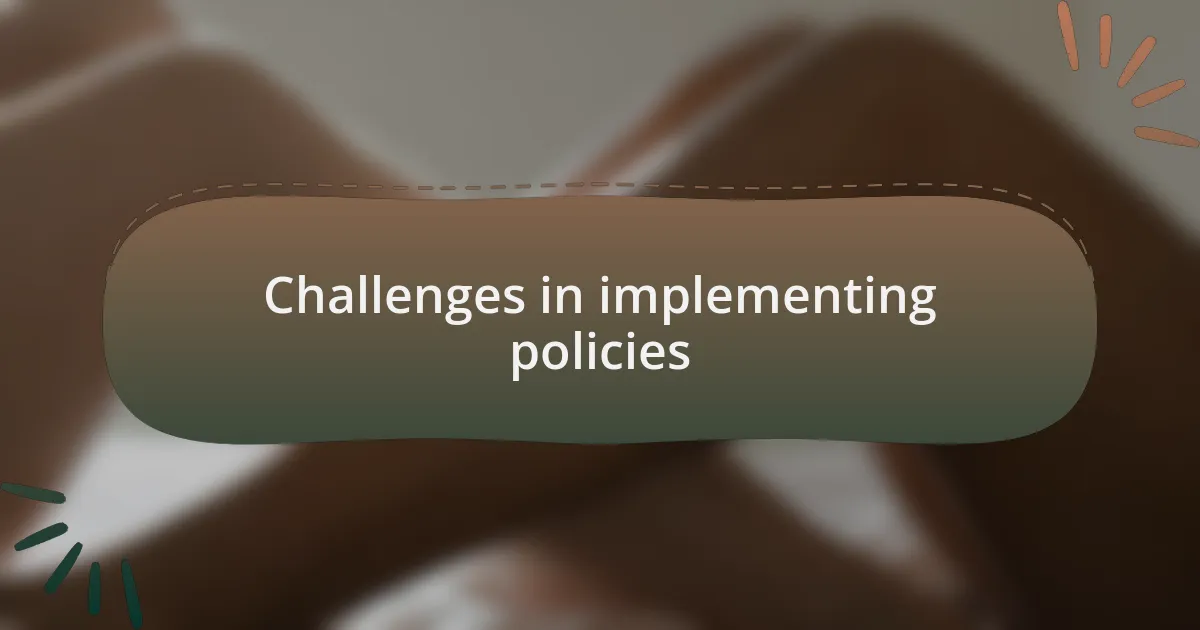Key takeaways:
- Family leave policies are crucial for supporting employees through significant life events, balancing work and family responsibilities.
- Equitable leave policies foster gender equality by encouraging shared parenting responsibilities and valuing both genders in the workplace.
- Implementing family leave policies faces challenges such as management resistance, legal complexities, and cultural stigma.
- The future of family leave may include flexible options and innovations like “leave banks,” prioritizing compassion and support in work cultures.

Understanding family leave policies
Family leave policies are essential in supporting employees during significant life events, such as the birth of a child or caring for sick relatives. When I think about this, I remember a friend who took leave after her baby was born; the peace of mind it provided her was invaluable. These policies enable individuals to balance work with their familial responsibilities, creating a more compassionate workplace.
Understanding the nuances of family leave can be tricky. For instance, some policies are paid, while others are unpaid, which can lead to stress for those who need to take time off but worry about financial stability. Have you ever faced the difficult decision of choosing between work and family? I have, and it’s a heavy burden that highlights the importance of supportive leave policies.
Moreover, it’s not just about the time off; it’s about fostering an inclusive environment that acknowledges the diverse needs of families. I’ve seen companies with comprehensive family leave policies thrive in employee satisfaction and retention. It’s this kind of forward-thinking approach that can set a workplace apart and truly demonstrate a commitment to gender equality and family support.

Impact on gender equality
When implementing family leave policies, I believe the ripple effects on gender equality can be profound. For instance, when fathers take paternity leave, it challenges traditional gender roles and promotes shared parenting responsibilities. I recall a colleague who took leave when his child was born; his willingness to step into the caregiver role not only deepened his bond with his child but also shifted perceptions around men’s involvement in family life.
Moreover, equitable leave policies can significantly impact workplace dynamics. I’ve noticed that when organizations actively promote both parental leave for mothers and fathers, it fosters a culture where both genders feel equally valued. Why should childcare and family responsibilities fall disproportionately on women? It’s not just about legal compliance; it’s about creating a genuine shift toward equality in the workplace.
The consequences of neglecting these policies can be damaging. I’ve seen talented women sidelined in their careers due to a lack of adequate leave when starting a family. This not only affects their professional growth but also perpetuates a cycle where gender imbalance in leadership roles persists. It’s crucial for companies to recognize that supporting family leave is an investment in all employees’ futures.

Benefits of family leave
The benefits of family leave go far beyond individual families; they resonate throughout society. I still remember when one of my friends took extended leave to care for her newborn. The joy and relief she felt knowing she could bond with her baby without the pressure of work were palpable. This experience reinforced my belief that family leave can improve mental health, allowing parents to focus on their loved ones during critical early months.
Another significant aspect of family leave is its positive effect on employee retention. In my own workplace, I’ve seen coworkers who utilized parental leave come back with renewed energy and loyalty. They felt valued by an organization that supported their personal milestones. Isn’t it great when employees are both happy at home and engaged at work? It creates a win-win situation for everyone involved.
Additionally, family leave can enhance workplace diversity. When companies embrace comprehensive leave policies, they attract a wider range of applicants, including those who prioritize family life. I’ve chatted with aspiring professionals who want to start families and genuinely worry about how that will affect their careers. Providing family leave not only reassures them but also enriches the workplace with diverse perspectives and experiences.

Challenges in implementing policies
Implementing family leave policies often runs into resistance from management due to concerns about productivity and costs. I recall a conversation with a colleague who managed a small team; she worried that allowing employees time off would burden the remaining staff. This mindset can hinder progress, as it overlooks the long-term benefits of a more supported workforce.
Another challenge lies in navigating the legal and bureaucratic landscapes that vary significantly across regions. When I was helping a friend advocate for better leave policies in her startup, we found ourselves entangled in a web of regulations that left us more confused than empowered. It’s frustrating how complex laws can stifle the motivation to support families adequately.
Lastly, there’s the deeply ingrained cultural stigma around taking leave. I can’t help but think back to my own experience when I hesitated to take family leave during a family emergency. The lingering fear of being perceived as less dedicated to my job was overwhelming. This societal pressure creates an unbalanced environment where employees may feel guilty for prioritizing their family responsibilities, stalling the implementation of supportive leave policies.

Personal experiences with family leave
During my first experience with family leave, I felt a mix of relief and guilt. I had been juggling work responsibilities while trying to care for my ailing parent. When I finally decided to accept the leave, I was hesitant; would my team manage without me? This internal struggle highlighted how often we weigh our personal needs against our professional obligations.
I remember another time when I encouraged a friend to take her maternity leave. She was anxious about falling behind at work, but the moment she finally took that step for her health and her baby, I could see a transformation in her—her happiness radiated, and it sparked an important conversation among our peers. Why is it that society often equates time off with lack of commitment, when, in reality, supporting family leave can enhance overall productivity?
Reflecting on these experiences, I wonder how many people are silently battling the stress that comes with the fear of taking leave. More than just a policy discussion, family leave is about recognizing our human needs. I’ve seen firsthand how policies can either empower or inhibit employees, and that makes me passionate about advocating for changes that truly support families.

Strategies for effective advocacy
One effective strategy for advocacy is leveraging storytelling to highlight the human impact of family leave policies. I recall sharing a story at a community meeting about a coworker who faced mental health struggles due to a lack of support during his mother’s illness. As I recounted his journey, I saw heads nodding in understanding; stories connect us deeply and resonate more than mere statistics.
Another avenue worth exploring is forming coalitions with other organizations that share similar advocacy goals. When I partnered with a local group focused on women’s rights, we realized our mutual objectives could amplify our voices. I remember our joint campaign addressing family leave gaps not only increased community awareness but also created a significant push for policy change—a powerful reminder that collective action can spark real transformation.
Finally, engaging policymakers through personal interactions can be incredibly effective. I’ve had success in setting up meetings with local representatives where I shared firsthand accounts of how inadequate leave affects families. The emotional weight of personal experiences often catalyzes lawmakers to take action. Have you ever considered how a simple conversation can lead to meaningful change? I’ve seen the profound impact it can have on creating policies that truly consider the needs of families.

Future of family leave policies
The future of family leave policies is poised for significant transformation, driven largely by the evolving needs of modern families. I remember attending a panel discussion where a father passionately shared how he felt had to choose between his job and being present for his newborn’s first months. This kind of emotional testimony underscores the urgency for reforms that would allow both parents to participate without risking their livelihoods.
As I observe the growing dialogue around gender equality, it’s clear that inclusive leave policies are gaining traction. The shift towards shared parental leave has the potential to not only support families but also challenge traditional gender roles, welcoming a new era of workforce dynamics. Have you thought about how these changes could redefine career paths and parenting responsibilities? It’s exciting to envision how equitable policies could empower everyone involved.
Looking ahead, we may also see an increase in the integration of flexible leave options that can adapt to personal circumstances. The concept of “leave banks,” where employees can share their leave with colleagues in need, is one innovative solution that I believe merits serious consideration. This approach not only fosters community within the workplace but also amplifies the message that supporting one another is vital during life’s critical moments. What if we could create work cultures that prioritize compassion and support, reshaping our expectations around work and life balance?